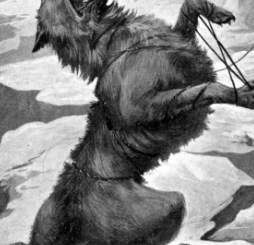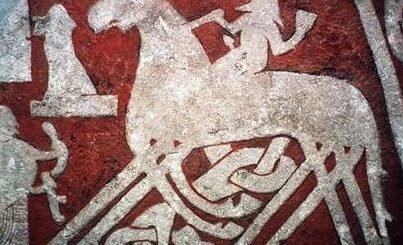Týr – Norse God of War

Týr in Norse mythology
Týr, also spelled Tiw or Tyr, is the Norse and Germanic god of War. He is said to value traits such as honor, bravery, fairness, and justice. As a result, he was a very important god in Norse pantheon. He is famed in the pantheon for being heroic and honorable. He was also praised for using his skills, abilities and knowledge to prevent unnecessary bloodshed and war, rather than start them.
Below World History Edu delves into the origin story and major myths surrounding Týr, including the famous story of how he lost his right hand to the mighty wolf Fenrir.
Family
In Skáldskaparmál, the second part of the Prose Edda, Týr is regarded as the son of the Allfather Odin. However, there are some accounts (i.e. Hymiskvida) that depict him as the offspring of the jotunn Hymir.
Also in the poem Hymiskviða (‘the lay of Hymir), Týr narrates the story of how he and the god Thor embark on a journey to secure the cauldron of the jötunn Hymir.
Týr vs. Loki
Týr is also mentioned in a number of poems from the Poetic Edda, including Lokasenna and Sigrdrifumal. In the latter poem, Loki gets into a flyting contest (i.e. quarrel) with many of the Norse gods that were attending a feast. After the Vanir goddess Freya (Freyja) is insulted by Loki, Týr steps in and orders Loki to stop his rain of insults against the gods.
Loki then responds by making mockery of Týr’s severed right hand, stating that the god did not deserve to be the “right hand of justice” because he had lost his right hand. Loki also brags about his affair with Týr’s wife, stating that he had a son with Týr’s wife.
The bravest and most just god in Norse pantheon
In many pantheons across the ancient world, war gods and goddesses were often feared and outright evil. Take the case of the Egyptian pantheon and the god Seth, a deity known for wanton chaos and destruction. Similarly, the Greek pantheon has the god Ares, whose thirst for bloodshed and anarchy knew no bounds.
With respect to Týr in the Norse pantheon, the god was in fact a respectable and honorable deity. He only went to war to uphold justice, truth and order. In the myth, he is praised for his bravery and his never-ending quest for justice. In a way, Týr being the god of war meant that the Norse people viewed him as the upholder of peace treaties and oaths.
Týr and the Great Wolf Fenrir

The book Gylfaginning in the Prose Edda describes Týr as the bravest and one of the most noble deities in Norse pantheon. Image: “Týr sacrifices his arm to Fenrir” in an illustration by John Bauer, 1911
Born to Loki, the Norse god of mischief, and the giantess Angrboda, the ferocious wolf Fenrir had a number of encounters with the Norse gods. Among all the Norse gods, Týr was the only one brave enough to approach the wolf to feed it.
Upon hearing the prophesy of the death Odin at the hands of Fenrir during Ragnarok, the Norse gods proceeded to chain Fenrir. The fact that the wolf kept growing at alarming rate made the gods even more frightful of the beast.
The gods tasked the dwarfs to forge an unbreakable chain that was made from six magical materials. The materials were the roots of a mountain, the beard of a woman, the sinews of a bear, the breath of a fish, the sound of a cat’s footfall, and the spittle of a bird. Once complete, the magical chain, which was also known as Gleipnir, was presented to the gods.
The gods played a trick on Fenrir by telling the giant wolf that they needed to bound him in order to test how strong the chain was.
Fenrir agreed to do so, however, on the condition that one of the gods placed his/her hands in its mouth. With the gods fully aware of the trick they wanted to play on Fenrir, no god volunteered, except Týr. The god of war was willing to sacrifice his hand in order to see Fenrir chained up. As expected, when Fenrir got to know that the gods had tricked him, he ripped Týr’s right hand off.
Týr in Ragnarok
According to the prophecies, a good number of Norse gods are destined to die during Ragnarok, a great battle that pits the Norse gods against the forces of evil and chaos. Týr is one of those gods that don’t make it out alive. The god of war, in spite of his brave displays, will be mauled to death by Garm, the fierce Hellhound of the underworld. Týr and Garm fight to the bitter end, with both killing each other.

The character High in the poem Gylfaginning talking about Týr’s death during Ragnarok
Read More: Top 10 Norse Gods and Goddesses
Facts about Týr
1- What is Týr the god of?
In Norse mythology, Týr is the god of war, law, honor and oaths.
3- Who are Týr’s siblings?
As a son of Odin, Týr’s half-siblings are Baldr, Rindr, Váli, and Thor.
4- Who are Týr’s parents?
According to the Prose Edda, Týr is the son of Odin.
More on Týr

Prior to Odin’s worship gaining popularity, Týr was the most revered god in the Norse pantheon. Picture: Týr by Lorenz Frølich, 1895
- Before Odin became popular among Scandinavian and Germanic cultures, Týr was the most famous deity in the pantheon. This was due those cultures insatiable appetite for war and raids.
- Did you know: the word Tuesday in English came from Týr’s name?



























